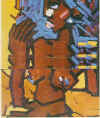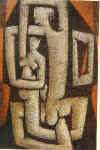| the-south-asian.com AUGUST 2001 | ||
| about us contact us data bank past issues the craft shop the print gallery | ||
|
SOCIETY & CULTURE Traditional
societies - Wisdom and Challenges SOUTH ASIAN FEATURE Hands
Across Borders INTERVIEW
Shantiniketan
and origin of Modern Art
Reinventing
India
Royal
Bengal's last roar?
|
Page
1 of 3 Modern Idiom in Contemporary Pakistani Art By Nillofur Farrukh
In the early post -1947 decades, the artists in Pakistan adopted Modernism not as perpetuation of the First World hegemony but as a metaphor for change and economic freedom. The society was no longer being viewed in stereotypes or idealised images, but as an evolving nation faced with the challenges of transition. In 1947 Lahore boasted of two art institutions and an expanding artists’ community. Karachi had very little post-Partition art activity, which expanded and became enriched by the arrival of pioneering talent in the exodus of displaced people from all over the sub-continent. In the early 1950s The Lahore Group initiated experimentation in the Modern idiom and had a seminal influence on contemporary Pakistani art. Ahmed Parvez, Shemza, Ali Imam, Moyene Najmi, Sheikh Safder and Qutub Sheikh were members of this informal group and like the Progressive group of Artists, were also inspired by the Paris School. These painters looked upon the new aesthetics of Modern Art as a manifestation of a technological and industrial progress leading to economic freedom, as it had brought to the west. Modern Art also seemed to be the chosen visual language that was compatible with the national poet Iqbal’s philosophy of ‘khudi’ or ego as a dynamo that would propel man towards personal success. In this milieu traditional art seemed inadequate to articulate the dreams and fears of a generation poised to enter a new era of freedom. Those educated in the English medium schools with greater exposure to global changes, readily adopted the western idiom and recognised it as a vehicle of progress. The majority, who were unread or received their education in the traditional medium or ‘madrasas’ developed a suspicion of western values and regarded them as vestiges of the colonial heritage and opposed to the spirit of Islam. Their path to progress lay through a revival of indigenous socio-political values. The art that emerged from the studios of the Modernists, because of its economically advantaged status, came to dominate the national art scene by the 1960s. The art of the East Pakistani [now Bangladesh] painters had a tremendous impact on their counterparts in Lahore, Karachi, Rawalpindi and Peshawar, who had yet to reach that mature understanding of the discipline. Artists such as Zainul Abedin had already bridged the gulf between folk art and contemporary art. Mansur Rahi, a student of Zainul Abedin, became one of the pioneer teachers at Karachi School of Art where his pedagogic influence on the young watercolorists heralded an aquarelle revival in the 1980s. Rahi became a faithful exponent of analytical cubism and developed his oeuvre under the influence of this style. The Lahore Art Group was committed to modern art but before it could become a cohesive movement its activities were disrupted by political interference. After a gap, when they returned to mainstream art activity, their will had been blunted and the spirit lost. The 60s also saw the American cultural impact on Pakistani urban centres. Films and publications were freely shown and distributed, and media were used to promote United States’ first art movement – Abstract Expressionism. Through visiting exhibitions and art historians, Pakistani artists received considerable exposure to abstract styles from America.
Copyright © 2000 - 2001 [the-south-asian.com]. Intellectual Property. All rights reserved. |
|


